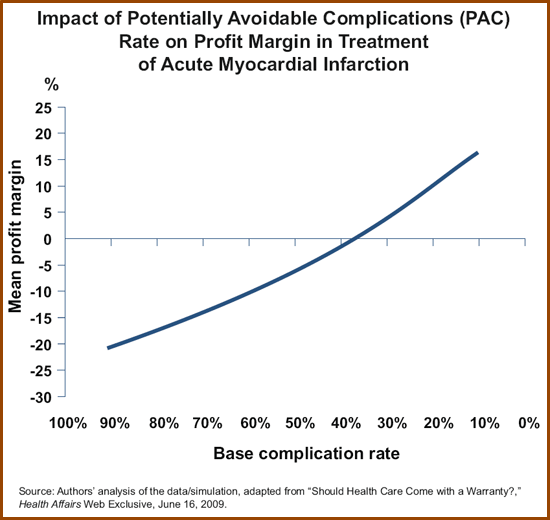Full text is available at:
http://content.healthaffairs.org/cgi/content/abstract/hlthaff.28.4.w678?ijkey=a7J7Z9oXbmt0Q&keytype=ref&siteid=healthaff
Synopsis
Warranties are commonly used in various industries to protect consumers against faulty products, but they are rare in health care. This study finds that warranties could improve the care that patients receive while enabling medical providers to improve their profit margins.
The Issue
To be feasible, product warranties must define which failures are the supplier's fault and which are not. In health care, the primary sources of "product failure" that are beyond the provider’s control are patient factors such as health status, comorbidities, and failure to adhere to discharge instructions. Other sources of failure may be controllable by providers, including those stemming from poorly coordinated care, errors of omission and commission, and other actions that harm patients or fail to improve their outcomes.

Using data from a large commercial insurance database, the authors modeled the impact of a new payment model that features a de facto warranty, in order to gauge the impact on providers' profit margins—specifically, for treatment of patients with acute myocardial infarction, or heart attack. Under the "Prometheus Payment" model, developed with support from The Commonwealth Fund and the Robert Wood Johnson Foundation, a risk-adjusted "evidence-informed case rate" (ECR) is used to reimburse providers for the care of a patient diagnosed with a specific condition. A global fee covers all services recommended by well-accepted clinical guidelines or expert opinions, including all inpatient and outpatient treatment delivered by physicians, hospitals, laboratories, and other providers. But while the ECRs fully compensate providers for the expected costs of providing evidenced-based care, they only compensate providers for half of the predicted cost of dealing with potentially avoidable complications—in effect, creating a warranty. Thus, providers “win or lose financially based on their actual performance in reducing the incidence of avoidable complications.”
Key Findings
- If the Prometheus model were applied to payments for the treatment of patients suffering from heart attack, providers would have to reduce their rates of potentially avoidable complications to roughly two-thirds of current rates in order to be consistently profitable.
- Profit margins did not suffer when providers treated more severely ill patients. In fact, profit margins increased slightly with the severity of illness.
- Profit margins decreased as the number of potentially avoidable complications—such as phlebitis—increased, and they decreased even more significantly as the average cost per complication increased.
Addressing the Problem
 Fee-for-service payments reward volume of services provided, not quality of care. In some cases, providers are even rewarded for poor care—through payments for the treatment of complications that could have been avoided. The authors say that health insurance coverage expansions will not be sustainable unless better and more cost-effective care is encouraged. The Prometheus Payment model offers one approach.
Fee-for-service payments reward volume of services provided, not quality of care. In some cases, providers are even rewarded for poor care—through payments for the treatment of complications that could have been avoided. The authors say that health insurance coverage expansions will not be sustainable unless better and more cost-effective care is encouraged. The Prometheus Payment model offers one approach.
About the Study
The researchers drew from a large commercially insured claims database to model an ECR for acute myocardial infarction (AMI) and determine both the total cost of potentially avoidable complications (PACs) and the allowance that would be assigned to any AMI ECR. The base price was set to cover the costs of typical cases, consistent with the best available evidence and expert consensus. The formula for determining the PAC allowance was designed to balance 1) the need to maintain incentives for providers to treat more severely ill patients, and 2) the need to minimize incentives for artificially increasing patient severity by using certain claims codes.
The Bottom Line
The use of warranties in provider payment systems could encourage health care providers to deliver higher-quality care, without suffering financial penalties for treating more severely ill patients.


